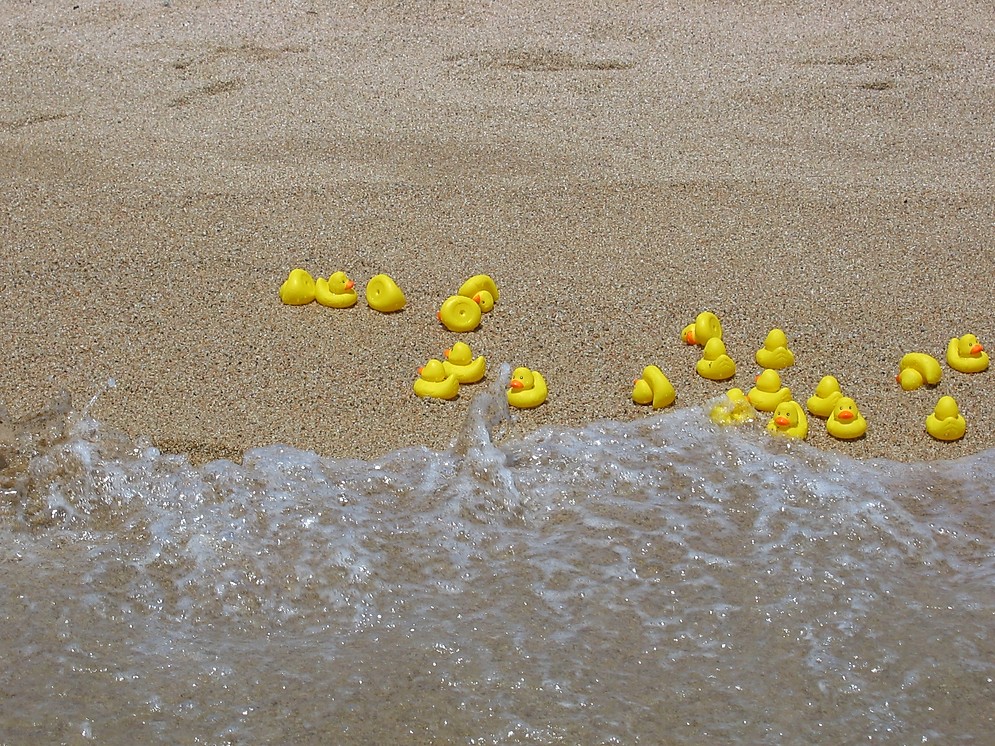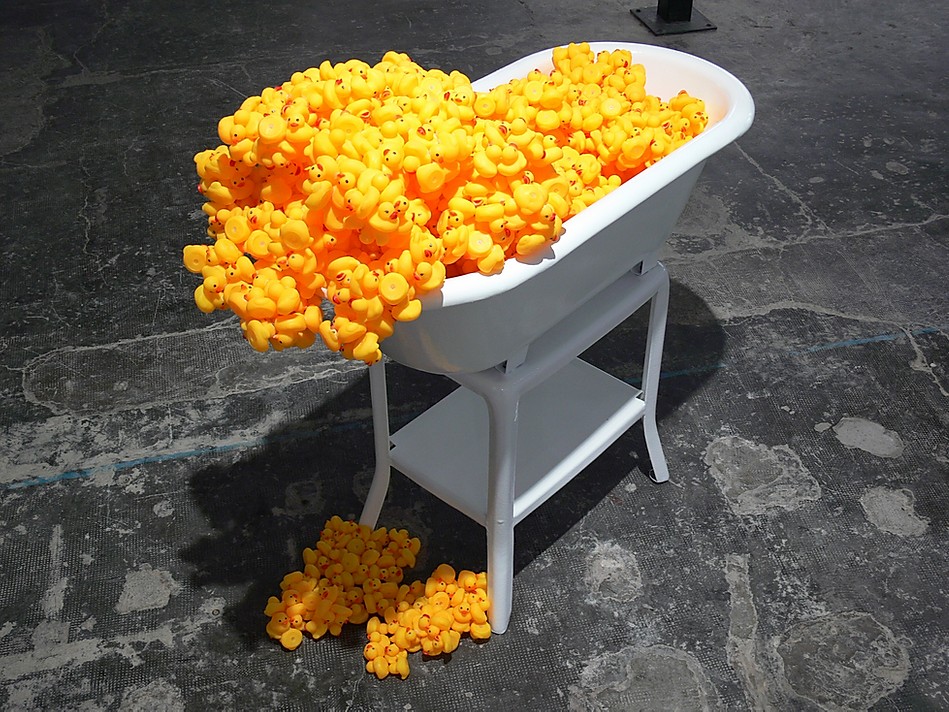
Essays & Publications
Nathalie Rey's Approach to Critical States
Essay
by Isabella Woldt
At a first glance, they appear like ordinary stuffed animals, but on closer inspection, the viewer realises that the cuddly monsters are different - they have lost their eyes or limbs and are tightly sewn together or disassembled. Rey has transformed them into monsters, carriers of thoughts, ideas, and emotions.
Millennium Monster I, 2018, stuffed animals sewed together, 127 x 75 x 75 cm
Stuffed animals are witnesses, collectors, and mediators of our childlike emotions. They are friends and companions that convey and suggest feelings, attraction, and warmth. They are the recipients of love but also of anger and dissatisfaction. Sometimes, looking at them as an adult, memories return to us. They live their own life, indepenend free moving in our memory (Meteorites, 2016). The submerged, seemingly forgotten, becomes alive again. Above all, the touch of the material, but also the round fairy-tale forms, just as they are attractive for children, attract us again and rekindle our thoughts (Tetris, 2016). Rey processes the material the way we process our experiences and emotions; she decomposes them to re-connect them. Rey's animals are deliberately destroyed, condensed, and then recompiled in order to create a new life and a new form but also to overcome the sources of fear in connection with new experiences. When Rey fragments the stuffed animals and places parts of them on the canvas, as in Composition I (2018), or Composition III (2019) the work becomes the projection screen of these processes.
The forms reflect the psychological processing of our thoughts, they are expression of internal critical state, Rey's micro-perception of critical states: We remember, reconstruct, deconstruct and recreate in these processes (Untitled 12, 13, 14, 2017). But above all we condense the thoughts and the experience, especially those of fears and relationships - we displace them to revive them.
In the Igloo of Barneo (2019), Rey expresses her reflection on our fears of climate change. Polar ice caps are now melting at alarming rates; thus the igloo symbolises the threat of this loss: when the ice has melted, we have lost with it our home. The cuddly toys in this piece also reflect the ambivalence of society: just as the stuffed animal is a positively charged object, it becomes a monster in Nathalie's work. Rey's title refers to a scientific camp in Barneo in the Arctic, where research is conducted. It is, however, also a place that is the starting point for adventure trips for the wealthy. Such trips reduce purpose of this research to absurdity. The stuffed animals in the Millennium Monster I (2018) cling to each other as the children cling to the mother in the symbolic figure of Caritas. And here, too, Mother Earth is well thought out.
The Igloo von Barneo, 2019, stuffed animals sewed on fabric fixed on metallic structure, 90x 160(diameter)cm
While in the Fukushima (2016) drawings where small colorful drawn animals attract the attention, Nathalie faces another threat from today's industry-nuclear energy, which is the next threat scenario for the future generations. Nathalie's work embraces and expresses a macroscopic view of ourselves and our actions by critically examining environmental issues and extensive industry, but these global fears are the fears of each of us as we contemplate the old stuffed animal of our childhood. These textiles are our memory.
Without title n° 10 (Fukushima), 2016, pencil and acrylic on paper, 33x46cm (from a series of 13, each unique)
Most recently, Nathalie concentrates on an art project that has been going on for several years, in which she deals intensively with the pollution of the seas by the intensive industry. She titled her project, which already consists of several parts, "Shipwreck", because it roots in the reflection about an accident that led to the leakage of thousands of plastic ducks from a ship.
Twenty years ago, a large group of plastic ducks "escaped" from their container during a violent storm. Carried on ocean currents across the globe, these emblems of childhood quickly captured the public's attention. So much so, in fact, that these ducks soon became popular in the contemporary art world, and, in one particularly avaricious case, a company manufactured imitations to satisfy the demands of thousands of collectors. But not all the interest was purely artistic or capitalistic. Scientists realized that, as the ducks were often found on distant and unexpected shores, they could perhaps teach us much about the complexities of ocean currents. Environmentalists, too, saw in them a conspicuous example of the permanence of all the plastic refuse we dump into the sea. For me, however, the ducks symbolize our globalized world, a world in which economy, ecology, science and art are all juxtaposed. In this way, toys, which often have the appearance of small animals, began to invade my drawings and my paintings. Like the stories of La Fontaine, these toys allow me to tell fables about the human race.I started a series with toys - more specifically my sisters' old and damaged stuffed animals - of very small format, painted on wooden blocks that resemble the blocks we played with as children. In parallel, I superimposed these stuffed animals into pencil drawings of various images of the Fukushima nuclear accident. Here the intention is multiple: to revive the tragic content of these images, unfortunately made commonplace by excess media coverage; to introduce the idea of the fragility of the human condition; and also to express my singular vision of the world from the only point of view bearable for me, namely innocence (Nathalie Rey, 2019).
Shipwreck I, photographic series, 2012, © N. Rey
Shipwreck I (Variation), 2019, Bathtub and 1500 rubber ducks, 120x90x50cm, © N. Rey
The ducks are not biodegradable and so they landed on the beaches as yellow toys, which, however, similar to stuffed animals - in the sense of an inversion, became the motif and symbol of the crisis and critical condition.
published 23 April 2020
Nathalie Rey
Composition with stuffed animals' remains IV (cell)
During the lockdown in Spain Barcelona in April 2020 Nathalie reflected on her situation. She felt affected by the separation from her studio. The thoughts turned into a creative thinking and the result became an increadible oversized artwork, a new project. And indeed the result seems to express her inner turmoil of being enclosed. A cell, in homage to Louise Bourgeois and Claude Manet's Water Lilies have been interwoven into a new art work. Nathalie expresses that situation and feeling with her words:
Is there such a mechanism as when our physical space shrinks, our mental space proportionally expands? Some fortuitous speculations (although current) to justify the improbable relationship of artists distant in time and in practice, I'm speaking in this case of Claude Monet and Louise Bourgeois. Because I had to surrender to the evidence that both are present in the work "Composition with stuffed animals' remains IV (cell).
Like many artists, when they reached a certain age, they both barely left their studio respectively in Giverny and New York, where they made some of their most ambitious works, such as the Water Lilies or part of the Cells, late in their career.
But let's get straight to the point and simply note that by spreading of the Water Lilies on the entire wall of the Orangerie's oval room, Monet had anticipated one of the challenges of modern and then contemporary art, namely the expansion of the art piece in the exhibit space, the passage from object to space. In this sense, perhaps Rothko was the painter who pushed further this idea of total immersion in colour with his monumental canvases and his famous chapel project in Houston (1971). Likewise, Bourgeois' work is exemplary, since, spanning almost a century, it evolved dramatically as the limits of conventional art changed. However, it would be inappropriate and simplified to present Bourgeois' work exclusively along this spectrum of a search for the objectivation and setting in space; although part of it evolved in this direction, it was also a consequence of the need to project a complex mental universe outside. In the continuity of the Cells, we can also mention the work of Joseph Beuys and, in particular, his lead room ("Hinter dem Knochen wird gezählt - Schmerzraum", 1983) or the house of Jean-Pierre Raynaud, in which he worked 20 years (1974-1993).
Thus I come to refine my initial hypothesis and suggest that, fundamentally, the artist's studio,Giverny's garden, the Water Lilies, Bourgeois' obsessions, her Cells, are equivalent "spaces".
In any case, the work "Composition with stuffed animals' remains IV (cell)" clearly borrows the spatial device based on a panoramic image, and even the idea of a life-size landscape, from the Water Lilies of the Orangerie, but also the psychological dimension particularly palpable in the Bourgeois' Cells series that consists in translating the mental space into a closed and self-referential physical space.
The series of works entitled "Composition with stuffed animals' remains" is part of a larger group in which these remains of stuffed animals are the raw material. These are, like other recurring figures in my work, the symbol both of childhood (and, by extension, the part of subjectivity assumed by the work) and of a popular culture anchored in the consumer society. Thus, the "Millennium Monsters" are the most literal and spectacular manifestation of this collision of two antagonistic concepts.

Sketch of the cell - External dimensions: 690 x 690 x 204 cm
The remains, fragments or residue of the soft toys are literally leftovers from the previous series. In a way, throwing away those discarded pieces of fabric for their obviousness, ugliness, or inadequacy would have been avoiding the problem. In fact, the stuffed animals I work with are, for the most part, edifyingly ugly; They are given to me or I find them in a second hand sale app, for the good reason that nobody wants them (in the best case because they got in the way). Then all sorts of naive questions arise: why do children have so many toys? What is the nature of this aesthetics that we think.
is suitable for kids? More generally, how do we get to this popular aesthetics of the cool, kawai, dull, cute, cheesy, etc.?
As my objective, in much of my work, is to work on this fine line between the criticism of some phenomena linked to capitalist society and mass culture and the appropriation of the same criticized phenomena, I found myself obliged to return their Letters of nobility to these residues of icons of the consumer society.
At first glance the result is a classic and "pretty" pictorial work. Then, with hindsight, long enough to realise that the colour spots have volume and that this volume corresponds to familiar shapes, the visitor is immersed (thanks to the cell device) in a universe attractive as much as strange, a bit like when you enter an amusement park, a false universe that twists reality, where the ugly becomes beautiful, unless it is the other way around.
Nathalie is currently preparing a new exhibition of that big size artwork in Barcelona, the place where she lives and works.

published 1st June 2020



